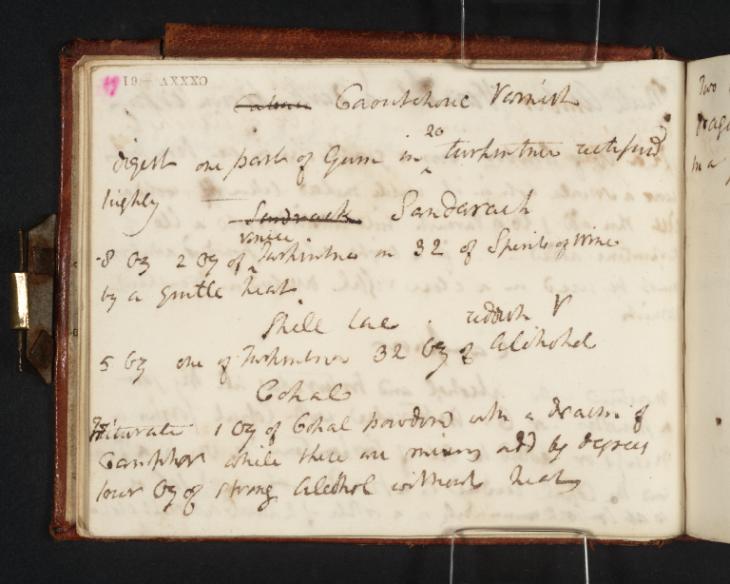Joseph Mallord William Turner Inscription by Turner: Notes from Nicholson's 'Dictionary of Practical and Theoretical Chemistry' c.1813
Joseph Mallord William Turner,
Inscription by Turner: Notes from Nicholson's 'Dictionary of Practical and Theoretical Chemistry'
c.1813
Joseph Mallord William Turner 1775–1851
Folio 61 Recto:
Inscription by Turner: Notes from Nicholson’s ‘Dictionary of Practical and Theoretical Chemistry’ c.1813
D09971
Turner Bequest CXXXV 61
Turner Bequest CXXXV 61
Pen and ink on white wove paper, 88 x 113 mm
Inscribed by Turner in ink with notes on chemistry (see main catalogue entry)
Inscribed by John Ruskin in red ink ‘61’ top left, upside down
Stamped in black ‘CXXXV – 61’ top left, upside down
Inscribed by Turner in ink with notes on chemistry (see main catalogue entry)
Inscribed by John Ruskin in red ink ‘61’ top left, upside down
Stamped in black ‘CXXXV – 61’ top left, upside down
Accepted by the nation as part of the Turner Bequest 1856
References
1862
Walter Thornbury, The Life of J.M.W. Turner, R.A. Founded on Letters and Papers Furnished by his Friends and Fellow-Academicians, London 1862 [1861], vol.I, p.359.
1897
Walter Thornbury, The Life of J.M.W. Turner, R.A. Founded on Letters and Papers Furnished by his Friends and Fellow-Academicians: A New Edition, Revised with 8 Coloured Illustrations after Turner’s Originals and 2 Woodcuts, London 1897, p.475.
1909
A.J. Finberg, A Complete Inventory of the Drawings of the Turner Bequest, London 1909, vol.I, p.386, CXXXV 61, transcribing inscription.
1992
Joyce H. Townsend, ‘Turner’s Writings on Chemistry and Artists’ Materials’, Turner Society News, no.62, December 1992, p.7, with transcription.
2011
Matthew Imms, ‘Not “quite out of his province”? Some New Identifications of Turner’s Working Notes’, Turner Society News, no.116, Autumn 2011, p.4.
The whole page is taken up with recipes for varnishes, which continue directly onto folio 60 verso opposite (D09970):
<Catou> Caoutchouc varnish
digest one part of Gum in [‘20’ inserted above a caret] turpentine rectified | highly –
<Sandrack> Sandarach
8 Oz 2 Oz of [‘Venice’ inserted above a caret] Turpentine in 32 of Spirits of Wine | by a gentle heat.
Shell lac. reddish V | 5 Oz one of Turpentine 32 Oz of Alchohol [sic]
Copal
Triturate 1 Oz of Copal powderd with a dracm of | Camphor while these are mixing add by degrees | four Oz of strong Alcohol without heat.
Without identifying its immediate origin, Joyce Townsend notes that the first recipe is a ‘gum or rubber varnish’, and that ‘triturate’ is a varnish-making term for ‘grind’.1 She also notes that the ‘copal spirit varnish’ recipe was ‘given by Sheldrake in 1799’ in a paper to the Society of Arts, as recognised by Katherine Ara from secondary sources.2
This is one of fourteen pages of notes on varnishes and colours resulting from chemical reactions between folio 62 verso (D09974) and folio 55 recto (D09959), working from the back of the sketchbook as now foliated. Thornbury recorded ‘notes of copal and other varnishes’ among his potted transcriptions from these passages.3 As discussed in the sketchbook’s Introduction,4 most are taken from William Nicholson’s 1808 Dictionary of Practical and Theoretical Chemistry, in this case from the unpaginated entry on ‘Varnish’:
A varnish of the consistence of thin turpentine is obtained for aërostatic machines, by the digestion of one part of elastic gum, or caoutchouc, cut into small pieces, in thirty-two parts of rectified oil of turpentine.
... a fine colourless varnish may be obtained, by dissolving eight ounces of gum sandarach in two ounces of Venice turpentine in thirty-two ounces of alcohol by a gentle heat. Five ounces of shell-lac and one of turpentine, dissolved in thirty-two ounces of alcohol by a very gentle heat, give a harder varnish, but of a reddish cast. To these the solution of copal is undoubtedly preferable in many respects. This is effected by triturating an ounce of powder of gum copal, which has been well dried by a gentle heat, with a drachm of camphor, and, while these are mixing together, adding by degrees four ounces of the strongest alcohol, without any digestion.
Turner continues his notes on varnishes on folio 60 verso opposite (D09970).
Matthew Imms
April 2014
Townsend 1992, p.7, with transcription (inadvertently omitting the ‘Shell lac’ recipe; followed here with slight variations).
Ibid., pp.7, 10 note 10; for the recipe ‘To dissolve Copal in Alcohol’ see the ‘continuation’ of Timothy Sheldrake, ‘Dissertation ... on Painting in Oil’, Transactions of the Society Instituted at London, for the Encouragement of Arts, Manufactures, and Commerce; with the Premiums Offered in the Year 1799, vol.17, 1799, pp.290–1.
How to cite
Matthew Imms, ‘Inscription by Turner: Notes from Nicholson’s ‘Dictionary of Practical and Theoretical Chemistry’ c.1813 by Joseph Mallord William Turner’, catalogue entry, April 2014, in David Blayney Brown (ed.), J.M.W. Turner: Sketchbooks, Drawings and Watercolours, Tate Research Publication, September 2014, https://www

